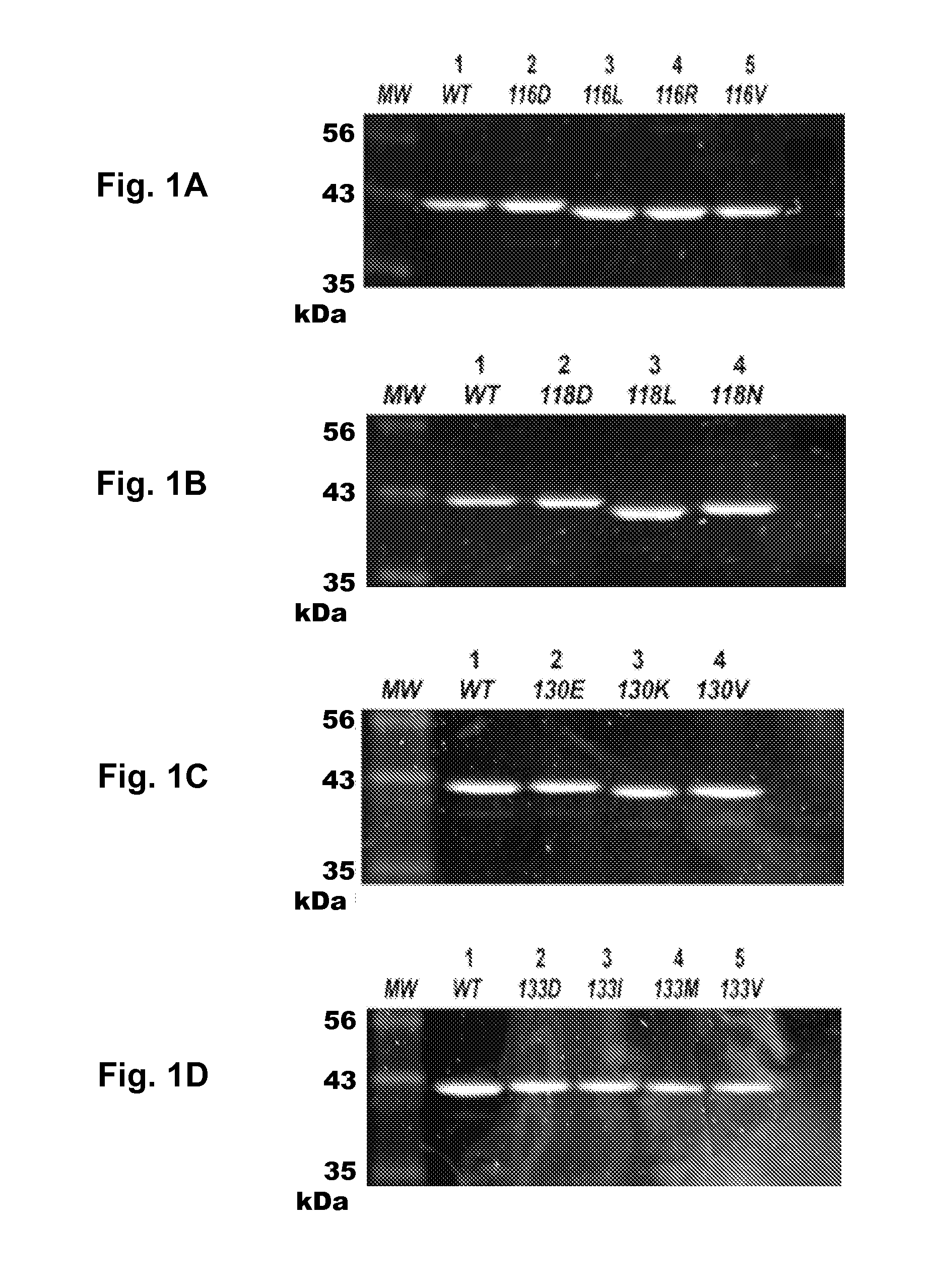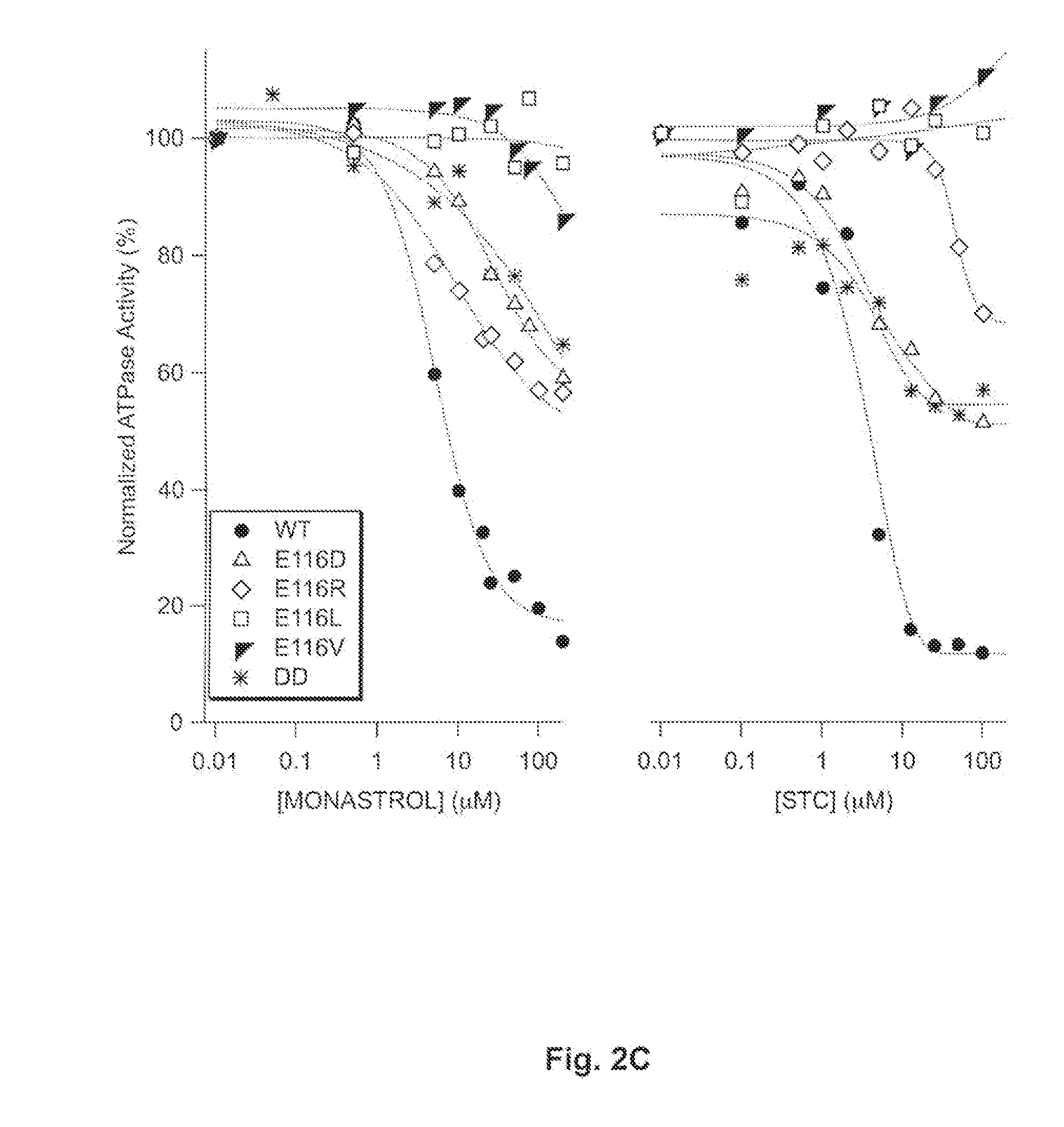Protein Structural Biomarkers to Guide Targeted Chemotherapies
- Summary
- Abstract
- Description
- Claims
- Application Information
AI Technical Summary
Benefits of technology
Problems solved by technology
Method used
Image
Examples
example 1
[0050]Materials and Methods
[0051]Generation of single- and double-mutants of Eg5. Starting cDNA was the truncated form of wildtype Eg5 as previously reported [residues 1-370; (28)]. Appropriate primers were synthesized and used for site-directed mutagenesis with the QuikChange II XL kit (Stratagene, La Jolla, Califf). Construction of the Eg5 motor domain with substitutions of Asp for E116 and E118 was performed using two rounds of mutagenesis. Expected mutations were confirmed by a single-read sequencing reaction. A subset of five mutations was completely sequenced on both strands to ensure that inadvertent coding errors were not introduced. The mutations produced are shown below in Table 1.
[0052]Motor protein expression and purification. The wildtype Eg5 kinesin motor domain, as well as single- and double-site polymorphisms, were expressed in BL21-Codon Plus (DE3)-RIL cell lines (Stratagene) and purified by cation exchange chromatography as previously described (28). Purity of wild...
example 2
[0059]Substitutions of L5 Residues Result in Altered SDS-PAGE Mobility
[0060]The initial step of this study was to assess how perturbations of the L5 loop affect Eg5 steady-state kinetics and solution structure. The first type of perturbation involves alteration of sidechain chemistry. Fifteen (15) mutations were sampled at four sites in the L5 loop: two at the N-tenninus and two at the C-terminus of the insertion loop. Prior studies scrutinizing the allosteric pocket typically assumed that point mutations have little effect beyond the localized change of a particular functional group. However, this stance can underestimate the ability of the point mutation to remodel the binding surface or transmit long-range effects that are dependent on the nature of the substitution. Therefore, the mutations used herein ranged from conservative to pleiotropic alterations; this allowed a wider range of chemical and structural outcomes at specific positions to be seen.
[0061]The N-terminal residues ...
example 3
[0064]Preservation of N-Terminal Local Structure and C-Terminal Chemistry in the L5 Loop are Required for Allostery and Catalysis.
[0065]There are marked kinetic differences between the N-terminal and C-terminal substitutions of L5 loop residues. Compared with wildtype samples, single-site substitutions of E116 decreased the steady-state, basal ATP hydrolysis rate of Eg5 kinesin monomers (FIG. 2A, open boxes). However, mutants of E118 displayed increased activity (FIG. 2A, filled boxes). These results were consistent, whether or not the amino acid substitutions were synonymous with carboxylates. These data demonstrated that the native interactions of E116 and / or E118 in the motor domain influence ATP hydrolysis rates achievable by Eg5. Moreover, for mutants of these two positions in the L5 loop, the faithful difference in mutant kinetic behavior, despite conservative or pleiotropic changes, implicated the native sidechain of these N-terminal L5 residues not primarily in electrostatic...
PUM
| Property | Measurement | Unit |
|---|---|---|
| Mass | aaaaa | aaaaa |
| Mass | aaaaa | aaaaa |
| Fraction | aaaaa | aaaaa |
Abstract
Description
Claims
Application Information
 Login to View More
Login to View More - R&D
- Intellectual Property
- Life Sciences
- Materials
- Tech Scout
- Unparalleled Data Quality
- Higher Quality Content
- 60% Fewer Hallucinations
Browse by: Latest US Patents, China's latest patents, Technical Efficacy Thesaurus, Application Domain, Technology Topic, Popular Technical Reports.
© 2025 PatSnap. All rights reserved.Legal|Privacy policy|Modern Slavery Act Transparency Statement|Sitemap|About US| Contact US: help@patsnap.com



